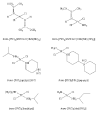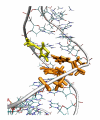Towards Antitumor Active trans-Platinum Compounds
- PMID: 20161688
- PMCID: PMC2821104
- DOI: 10.1002/ejic.200801118
Towards Antitumor Active trans-Platinum Compounds
Abstract
Substitution of NH(3) by a range of amines in trans-[PtCl(2)(NH(3))(2)] produces compounds with cytotoxicity significantly improved over the parent transplatin and in many cases equivalent to that of cisplatin. This microreview summarizes the chemistry and biology of trans-platinum compounds containing principally planar amines and succinctly reviews the current status of anticancer relevance of the trans-platinum geometry. The nature of bifunctional DNA adducts (intrastrand, interstrand) is remarkably dependent on the nature of the amine. Further, the stability of monofunctional adducts allows for competitive production of DNA-protein crosslinks and overall the results suggest that the trans-platinum chemotype may offer significant potential for design of selective DNA-protein crosslinking agents. A subset of proteins known to bind to DNA modified by trans-platinum is that comprised of zinc fingers - model studies show the potential for formation of heteronuclear thiolate-bridged species as precedent for zinc displacement from the biomolecule.
Figures







Similar articles
-
DNA binding by antitumor trans-[PtCl2(NH3)(thiazole)]. Protein recognition and nucleotide excision repair of monofunctional adducts.Biochemistry. 2003 Jan 28;42(3):792-800. doi: 10.1021/bi026614t. Biochemistry. 2003. PMID: 12534292
-
DNA-protein cross-linking by trans-[PtCl(2)(E-iminoether)(2)]. A concept for activation of the trans geometry in platinum antitumor complexes.Nucleic Acids Res. 2003 Nov 15;31(22):6450-60. doi: 10.1093/nar/gkg863. Nucleic Acids Res. 2003. PMID: 14602903 Free PMC article.
-
DNA modifications by a novel bifunctional trinuclear platinum phase I anticancer agent.Biochemistry. 1999 May 25;38(21):6781-90. doi: 10.1021/bi990124s. Biochemistry. 1999. PMID: 10346899
-
Trans-diammineplatinum(II): what makes it different from cis-DDP? Coordination chemistry of a neglected relative of cisplatin and its interaction with nucleic acids.Met Ions Biol Syst. 1996;33:105-41. Met Ions Biol Syst. 1996. PMID: 8742842 Review.
-
Trans-platinum complexes in cancer therapy.Anticancer Agents Med Chem. 2007 Jan;7(1):111-23. doi: 10.2174/187152007779314080. Anticancer Agents Med Chem. 2007. PMID: 17266508 Review.
Cited by
-
Luminescent iminophosphorane gold, palladium and platinum complexes as potential anticancer agents.Inorg Chem Front. 2014;1(3):231-241. doi: 10.1039/C4QI00003J. Epub 2014 Mar 7. Inorg Chem Front. 2014. PMID: 27660713 Free PMC article.
-
The Next Generation of Platinum Drugs: Targeted Pt(II) Agents, Nanoparticle Delivery, and Pt(IV) Prodrugs.Chem Rev. 2016 Mar 9;116(5):3436-86. doi: 10.1021/acs.chemrev.5b00597. Epub 2016 Feb 11. Chem Rev. 2016. PMID: 26865551 Free PMC article. Review.
-
Rational design of [Co(acacen)L2]+ inhibitors of protein function.Dalton Trans. 2013 Mar 21;42(11):4002-12. doi: 10.1039/c2dt32565a. Epub 2013 Jan 22. Dalton Trans. 2013. PMID: 23340849 Free PMC article.
-
Axial ligand exchange of N-heterocyclic cobalt(III) Schiff base complexes: molecular structure and NMR solution dynamics.Inorg Chem. 2013 Jan 18;52(2):1069-76. doi: 10.1021/ic302379j. Epub 2013 Jan 2. Inorg Chem. 2013. PMID: 23282130 Free PMC article.
-
Structural basis for the bypass of the major oxaliplatin-DNA adducts by human DNA polymerase η.Biochem J. 2019 Feb 28;476(4):747-758. doi: 10.1042/BCJ20180848. Biochem J. 2019. PMID: 30709915 Free PMC article.
References
-
- Kelland L. Nat Rev Cancer. 2007;7:573–584. - PubMed
-
- Jung YW, Lippard SJ. Chemical Reviews. 2007;107:1387–1407. - PubMed
-
- Farrell N. Metal Ions in Biological Systems. 2004;42:251–296. - PubMed
-
- Hollis LS, Sundquist WI, Burstyn JN, Heiger-Bernays WJ, Bellon SF, Ahmed KJ, Amundsen AR, Stern EW, Lippard SJ. Cancer Research. 1991;51:1866–1875. - PubMed
-
- Farrell N, Ha TTB, Souchard JP, Wimmer FL, Cros S, Johnson NP. Journal of Medicinal Chemistry. 1989;32:2240–2241. - PubMed
Grants and funding
LinkOut - more resources
Full Text Sources
